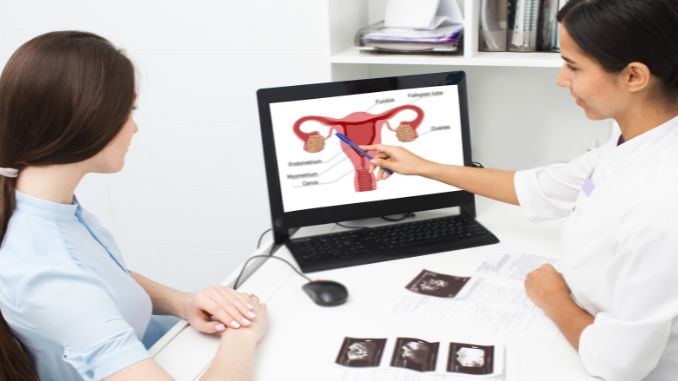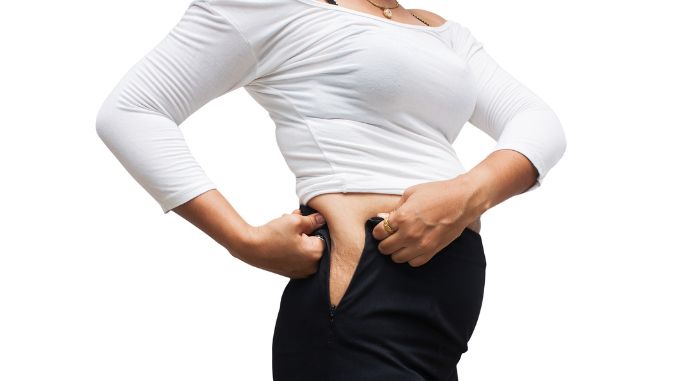Endo belly [¹] refers to a specific symptom of endometriosis where the abdomen becomes severely bloated, especially during the second half of the menstrual cycle before menstruation. This bloating or stomach pain causes discomfort due to the inflammation and irritation of the pelvic area.
The bloating occurs due to inflammation and irritation from endometrial-like tissue outside the uterus, resulting in gas and fluid buildup, causing abdominal distention resembling pregnancy, which may leave some women questioning, “Why do I look pregnant?“
These tissues can affect various parts of the body, like the pelvic area, abdominal cavity, stomach muscles and lower back, leading to bloating.
Factors influencing endo belly include:
- Hormonal fluctuations during the menstrual cycle that exacerbate inflammation.
- A reduced pain threshold in the intestinal walls, similar to that observed in Irritable Bowel Syndrome (IBS).
- Possible co-occurrence with other conditions like IBS, which can complicate and worsen the symptoms.
What is Endometriosis?

Endometriosis is a common condition [²] affecting up to 10% of women of childbearing age. It causes significant lower abdominal pain and can lead to difficulty in becoming pregnant. This makes it a big health problem. It’s the third most common reason women go to the hospital for gynecologic issues and one of the main reasons they need to have their uterus removed in the U.S.
Endometriosis occurs when the tissue that usually lines the inside of the uterus grows outside of it, and spreads to the pelvic and belly area [³]. The most common theory is that this occurs because menstrual blood flows backward.
Other possible causes include problems with the immune system and the lining of the uterus. Endometriosis can lead to the formation of abnormal tissue growth in the pelvic [⁴] and abdominal are causing pain and affecting the function of abdominal muscles.
Why Do I Look Pregnant from Endo Belly?
Endo belly is a term used to describe the severe bloating that many people with endometriosis experience. This bloating can cause the abdomen to swell and resemble a pregnant belly, leading to the question “Why do I look pregnant from endo belly?” Here are some reasons why endo belly can make you look pregnant:
- Inflammation: Endometriosis causes tissue to grow outside the uterus, leading to chronic inflammation, swelling, and fluid retention in the abdomen.

- Trapped Gas: It can affect the intestines, causing gas and bloating, which expands the abdomen.
- Hormonal Fluctuations: Hormonal changes, especially during the menstrual cycle, can increase bloating, with estrogen causing water retention.
- Fluid Retention: Inflammation from endometriosis can lead to fluid buildup in the abdomen, making it look swollen.
- Bowel Involvement: When endometriosis affects the bowel, it can cause constipation, diarrhea, and bloating.
- Diet and Food Sensitivities: Many with endometriosis are sensitive to foods like dairy, gluten, and high-FODMAP foods, which can worsen bloating.
- Adhesions and Abnormal Tissue Growth: Endometriosis can create abnormal tissue growth that binds organs together, disrupting intestinal function and causing persistent bloating. Endo belly can get worse because of scar tissue, which forms from abnormal growths that stick organs together and cause swelling and bloating. This can lead to the question “Why do I look pregnant from endo belly?”
Treatment Approaches for Endo Belly
1. Medical Therapy

- Oral Contraceptives: Help manage symptoms like dysmenorrhea and endometriosis-associated pain. Birth control pills containing 20-35 micrograms of ethinyl estradiol, taken daily for six to nine months, can help achieve symptomatic relief.
- Androgenic Agents: Used to reduce symptoms.
- Progestins: Hormonal treatment to control symptoms. One sample is Medroxyprogesterone acetate (Provera, Pharmacia-Upjohn, Peapack, NJ).
- Gonadotropin-Releasing Hormone (GnRH) Analogs: Currently the most popular medical therapy, including:
a. Leuprolide Acetate
b. Goserelin Acetate
c. Nafarelin Acetate
2. Surgery

Especially helpful for severe endometriosis.
- Laparoscopy: A common surgery where doctors remove visible endometriosis
3. Combination Therapy
Using both medicines and surgery together to treat a condition.
Approaches that could help manage Endo belly Symptoms
- Dietary Adjustments: Track foods causing bloating, avoid triggers like processed items, red meat, and sugars, and opt for anti-inflammatory foods like leafy greens and fish. Use a food diary. For IBS-like symptoms, try a low-FODMAP diet to ease gut fermentation, reducing bloating and discomfort. A low-FODMAP diet is a way of eating that avoids certain types of carbohydrates that can cause digestive problems.
- Regular Exercise: Try gentle exercises like walking, yoga, or swimming to boost circulation and ease inflammation, aid digestion, and reduce bloating. Avoid intense workouts to prevent worsening symptoms. Pelvic floor exercises can target affected muscles, easing pressure and bloating.
- Stress Management: Getting psychological support [⁵] through counseling or therapy is important for managing the mental impact of endometriosis. Stress-reduction techniques such as meditation or deep breathing can help alleviate symptoms and decrease inflammation, potentially reducing the occurrence of endo belly.
- Adequate Hydration: Stay hydrated by drinking lots of water daily to aid digestion and minimize bloating. Hydration helps eliminate toxins, aids digestion, and prevents constipation, a common trigger for endo belly. Skip sugary and caffeinated drinks, as they can dehydrate you and worsen inflammation, exacerbating endometriosis-related bloating.
- Herbal Remedies: Some herbs, like ginger and peppermint, help with digestion and inflammation. Ginger can ease nausea and aid digestion, while peppermint relaxes the stomach, relieving cramps and gas. Before taking any herbs, talk to a healthcare provider to make sure they’re safe for you, especially if you’re on other medications.
Effects of Endo Belly
Endo belly, a symptom associated with endometriosis, can have several significant effects on a person’s life, both physically and psychologically:
1. Physical Effects

- Severe Abdominal Bloating: The abdominal area can become dramatically swollen, which is not only uncomfortable but can also affect appearance, leading to self-consciousness or distress.
- Increased Pain: These include severe dysmenorrhea (menstrual pain), chronic pelvic pain, dyspareunia (pain during sexual intercourse), dyschezia (pain during defecation), and gastrointestinal symptoms like bloating and nausea.
- Gastrointestinal Distress: Symptoms can include constipation, diarrhea, nausea, and vomiting, affecting daily activities and overall quality of life.
- Impact on Diet and Nutrition: The discomfort and pain may lead to dietary restrictions or changes, impacting nutritional intake and overall health.
- Impairment in Physical Activity: Due to pain and discomfort, engaging in normal physical activities or exercise can be challenging.
2. Psychological Effects

- Anxiety and Depression: Chronic pain and the unpredictability of endo belly can cause anxiety and depression, as individuals may feel overwhelmed by their symptoms.
- Social Isolation: The discomfort and need for frequent restroom breaks can make social outings difficult, potentially leading to social withdrawal or isolation.
- Impact on Body Image: The study highlights that endometriosis leads to substantial psychological distress. This distress is partly due to the chronic nature of the pain and the unpredictability of symptoms, which significantly impair the quality of life and mental health. The disease also impacts body image, leading to negative self-perception and lowered self-esteem due to physical changes and symptom burden.
- Stress: Dealing with chronic symptoms and navigating medical treatments or misunderstandings about the condition can contribute to heightened stress levels.
3. Effects on Daily Life
- Work and School Disruptions: Symptoms may be severe enough to cause frequent absences from work or school, affecting performance and productivity.
- Relationship Strain: The chronic nature of the condition can strain personal relationships, particularly if partners or family members are not supportive or do not understand the severity of the symptoms.
Conclusion
Endo belly, a term used by those with endometriosis, refers to severe stomach bloating that can make individuals look pregnant. This bloating is not just uncomfortable but also a sign of inflammation and irritation caused by tissue growing outside the uterus.
It’s important to recognize that this bloating is a health issue, not just a cosmetic one. Managing endo belly involves dietary changes, stress management, and medical treatments. Addressing the root causes can greatly improve quality of life and relieve symptoms.
Tired of a bloated belly and pondering “Why do I look pregnant?” Our concise blog post covers endo belly, its causes, and treatments. Check out our Best Foods that Rapidly Slim & Heal in 7 Days guide to help you feel better.

Frequently Asked Questions
Why is my belly so big but I’m skinny?
If you’re thin but have a big belly, it could be due to poor eating habits, lack of exercise, bloating, or genetics. Poor posture can also make your belly stick out.
What food to eat when you have an endo belly?
When you have an endo belly, eat foods that are gentle on the digestive system. Opt for low-FODMAP foods like bananas, blueberries, carrots, spinach, and lean proteins like chicken and fish. Avoid dairy, gluten, and high-FODMAP foods to reduce bloating and discomfort. Drink plenty of water.
List of high-FODMAP foods to avoid:
- Dairy Products: Milk, yogurt, soft cheeses, and ice cream
- Fruits: Apples, pears, mangoes, and cherries
- Vegetables: Onions, garlic, cauliflower, and mushrooms
- Wheat Products: Bread, pasta, and cereals made from wheat
- Legumes: Beans, lentils, chickpeas, and soybeans
- Sweeteners: Honey, high-fructose corn syrup, and artificial sweeteners like sorbitol and xylitol

Rick Kaselj MS, is a leading kinesiologist and injury specialist as well as co-creator of the best-selling Unlock Your Hip Flexors program. Rick creates exercise programs that help people heal injuries and eliminate pain, so they can go back to living a full, active, healthy life.



